san francisco
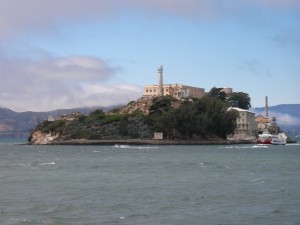 Sometimes, it has to be accepted that just maybe, something is impossible. Still, when a challenge seems impossible, there is always someone who comes along and proves that it can be done. Alcatraz island, and the prison that is located there were known to be impossible to escape from. Over the years that Alcatraz was open, there were 14 escape attempts. Myths and mysteries surrounded Alcatraz, and it’s seemingly inescapable water fortress for years. One of the many myths about Alcatraz is that it was impossible to survive a swim from the island to the mainland because of sharks. In fact, there are no “man-eating” sharks in San Francisco Bay, only small bottom-feeding sharks. The real obstacles the prisoners faced were the cold temperatures…which averaged 50 to 55 degrees Fahrenheit, the strong currents in the water, and the distance to shore, which was at least 1¼ miles. Those things combined were known to have bested most people who attempted to make it from Alcatraz to San Francisco.
Sometimes, it has to be accepted that just maybe, something is impossible. Still, when a challenge seems impossible, there is always someone who comes along and proves that it can be done. Alcatraz island, and the prison that is located there were known to be impossible to escape from. Over the years that Alcatraz was open, there were 14 escape attempts. Myths and mysteries surrounded Alcatraz, and it’s seemingly inescapable water fortress for years. One of the many myths about Alcatraz is that it was impossible to survive a swim from the island to the mainland because of sharks. In fact, there are no “man-eating” sharks in San Francisco Bay, only small bottom-feeding sharks. The real obstacles the prisoners faced were the cold temperatures…which averaged 50 to 55 degrees Fahrenheit, the strong currents in the water, and the distance to shore, which was at least 1¼ miles. Those things combined were known to have bested most people who attempted to make it from Alcatraz to San Francisco.
The prisoners tried every possible escape plan they could think of…from simply climbing over a fence to the most elaborate attempt which was made famous by the movie “Escape From Alcatraz,” when on June 11, 1962, 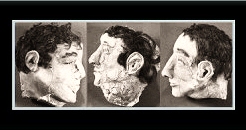 Frank Morris, and brothers John and Clarence Anglin cut through the walls, and made false walls to conceal their work, then placing “dummy heads” in their beds, so they would have all night to make their escape. Using raincoats turned into floatation devises, they made their escape. A cell house search turned up the drills, heads, wall segments, and other tools, while the water search found two life vests…one in the bay, the other outside the Golden Gate, oars, as well as letters and photographs belonging to the Anglins that had been carefully wrapped to be watertight. No sign of the men was found. Several weeks later a man’s body dressed in blue clothing similar to the prison uniform was found a short distance up the coast from San Francisco, but the body was too badly deteriorated to be identified. Speculation continues to this day as to whether or not the other two made it to safety.
Frank Morris, and brothers John and Clarence Anglin cut through the walls, and made false walls to conceal their work, then placing “dummy heads” in their beds, so they would have all night to make their escape. Using raincoats turned into floatation devises, they made their escape. A cell house search turned up the drills, heads, wall segments, and other tools, while the water search found two life vests…one in the bay, the other outside the Golden Gate, oars, as well as letters and photographs belonging to the Anglins that had been carefully wrapped to be watertight. No sign of the men was found. Several weeks later a man’s body dressed in blue clothing similar to the prison uniform was found a short distance up the coast from San Francisco, but the body was too badly deteriorated to be identified. Speculation continues to this day as to whether or not the other two made it to safety.
The official statement says they drown, and while it is likely that they did, it has been proven that it was indeed possible to swim from Alcatraz to San Francisco. Prior to the Federal institution opening in 1934, a teenage girl swam to the island to prove it was possible. Fitness guru Jack LaLanne swam to the island pulling a rowboat, 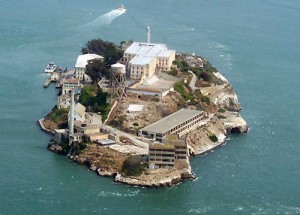 and several years ago two 10 year old children also made the swim. The official stand on that is that if a “person is well trained and conditioned, it is possible to survive the cold waters and fast currents. However, for prisoners, who had no control over their diet, no weightlifting or physical training (other than situps and pushups), and no knowledge of high and low tides, the odds for success were slim.” As to the escape attempts in which no body was ever found, we will never really know if they somehow managed to beat the odds and went on to live a quiet life under an assumed name or if they were swept away to be basically buried at sea. Either way, it is a very interesting subject to speculate on. I personally think that at least one of the three men made it.
and several years ago two 10 year old children also made the swim. The official stand on that is that if a “person is well trained and conditioned, it is possible to survive the cold waters and fast currents. However, for prisoners, who had no control over their diet, no weightlifting or physical training (other than situps and pushups), and no knowledge of high and low tides, the odds for success were slim.” As to the escape attempts in which no body was ever found, we will never really know if they somehow managed to beat the odds and went on to live a quiet life under an assumed name or if they were swept away to be basically buried at sea. Either way, it is a very interesting subject to speculate on. I personally think that at least one of the three men made it.
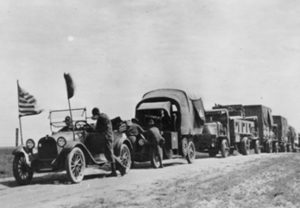
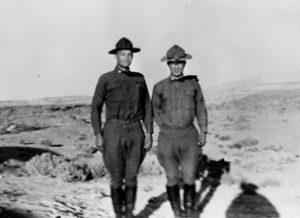 Have you ever wondered how the Interstate road system got started? People didn’t just wake up one day and envision a great system of roads that could transport us from one side of the country to the other. There had to be some reasons to do such a thing, right? Well, there was. In 1919, Dwight Eisenhower was feeling a bit disenchanted with life, because his wife and infant son were living 1,500 miles away in Denver, while he was a 28 year old lieutenant colonel stationed at Maryland’s Camp Meade. He was bored and miserable, and so he and his fellow soldiers wasted the hours playing bridge and complaining about being kept stateside during World War I. What do people do when they need to break through the boredom…what else, a road trip!!
Have you ever wondered how the Interstate road system got started? People didn’t just wake up one day and envision a great system of roads that could transport us from one side of the country to the other. There had to be some reasons to do such a thing, right? Well, there was. In 1919, Dwight Eisenhower was feeling a bit disenchanted with life, because his wife and infant son were living 1,500 miles away in Denver, while he was a 28 year old lieutenant colonel stationed at Maryland’s Camp Meade. He was bored and miserable, and so he and his fellow soldiers wasted the hours playing bridge and complaining about being kept stateside during World War I. What do people do when they need to break through the boredom…what else, a road trip!!
Eisenhower heard that two volunteer tank officers from Camp Meade were needed to participate in a coast to coast military convoy to San Francisco. It was the perfect adventure, so Eisenhower immediately volunteered his services. Granted, it wasn’t the thrill of battle that the young soldier had planned to spend his time in the service engaging in, but it was far better than playing bridge. Little did he know just how grueling the trip would be. Remember that these were the early years of the automobile, and drivers were just as likely to encounter roads to nowhere, as they were the open road. Highways were not usually paved. Dirt roads could be a muddy mess or so dry that they were either dust clouds or full of ruts. Sixty miles an hour was unheard of and many roads could only be driven at the pace of a brisk walk. As a means of transporting military equipment quickly from one coast to the other…this system left much to be desired, in fact it was a miserable excuse for a road system at all. Something had to change.
Fast forward a few years…37 years to be exact, and you will find then President Dwight D Eisenhower signing the Federal-Aid Highway Act of 1956 privately, without ceremony, on June 29, 1956. The system would take decades to build, and in reality is always under construction. The project was the largest public works project in American history. The project would pour billions of dollars into the nation’s economy all over the country, putting many people to work. Today, it continues to be a boon to the economy because of the maintenance and repairs needed to keep it going.
In 1990, as a tribute to Eisenhower, on the centennial of his birth, President George H W Bush redesignated the 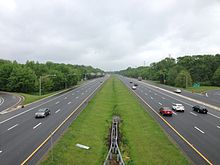
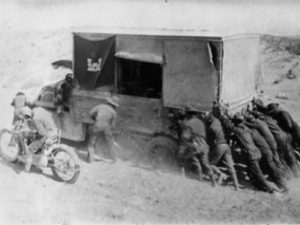 interstate system as the Dwight D Eisenhower National System of Interstate and Defense Highways. Interstate 80, would be quite familiar to Eisenhower. It starts just across the Hudson River from New York City, then goes through New Jersey and Pennsylvania, and into Ohio, where it follows generally the route of the 1919 Army convoy to San Francisco that had sparked Eisenhower’s interest in such a system in the first place.
interstate system as the Dwight D Eisenhower National System of Interstate and Defense Highways. Interstate 80, would be quite familiar to Eisenhower. It starts just across the Hudson River from New York City, then goes through New Jersey and Pennsylvania, and into Ohio, where it follows generally the route of the 1919 Army convoy to San Francisco that had sparked Eisenhower’s interest in such a system in the first place.
 Television was invented by a 21 year old man named Philo Taylor Farnsworth, and first successfully demonstrated in San Francisco on Sept. 7, 1927. It’s odd to think that my dad, Allen Spencer lived both before the invention of television and after it. I suppose that isn’t so very odd, because I have lived before and after the cell phone, and that doesn’t seem strange to me at all, so I suppose it didn’t seem strange to my dad either. Then, on March 25, 1954…just a month and a half before my sister, Cheryl Masterson was born, RCA announced that it had begun producing the first color television sets in its Bloomington, Indiana plant.
Television was invented by a 21 year old man named Philo Taylor Farnsworth, and first successfully demonstrated in San Francisco on Sept. 7, 1927. It’s odd to think that my dad, Allen Spencer lived both before the invention of television and after it. I suppose that isn’t so very odd, because I have lived before and after the cell phone, and that doesn’t seem strange to me at all, so I suppose it didn’t seem strange to my dad either. Then, on March 25, 1954…just a month and a half before my sister, Cheryl Masterson was born, RCA announced that it had begun producing the first color television sets in its Bloomington, Indiana plant.
I’m sure it was a while before most homes made the move to color televisions, and  then, of course, there was the wait for shows to be filmed in color. I know that I remember watching a black and white television, and I’m sure most people my age can say the same. The current generation would have no idea what it was like to watch a black and white television, or an early color television. They have seen everything from HD television, to cell phones with television, as well as tablets. The old televisions would seem completely antiquated…and in reality, my generation would look at them that way too. It amazes me just how quickly we get used to new technology, and it amazes me just how long people will hold on to the old stuff before making the transition too. I suppose some think that if it isn’t broken, there is no reason to replace it just yet, but others simply wait until the see how well this new fangled gadget is going to work, or if it’s around very long. So many fads come and go, and are never
then, of course, there was the wait for shows to be filmed in color. I know that I remember watching a black and white television, and I’m sure most people my age can say the same. The current generation would have no idea what it was like to watch a black and white television, or an early color television. They have seen everything from HD television, to cell phones with television, as well as tablets. The old televisions would seem completely antiquated…and in reality, my generation would look at them that way too. It amazes me just how quickly we get used to new technology, and it amazes me just how long people will hold on to the old stuff before making the transition too. I suppose some think that if it isn’t broken, there is no reason to replace it just yet, but others simply wait until the see how well this new fangled gadget is going to work, or if it’s around very long. So many fads come and go, and are never  heard from again. Others, like televisions, cell phones, and computers are here to stay.
heard from again. Others, like televisions, cell phones, and computers are here to stay.
Television sets have gone from average size to ultra big, to ultra small, and everything in between. Of course, as we all know, the television has continues to improve in color and clarity too. Sometimes I think the color is almost better than real life…if that’s possible. With new abilities in editing, color can be enhanced to amazing levels. I’m sure that there are some people who would think enhanced color is not a good thing, and sometimes…if it seems completely outlandish, I would have to agree, but when it comes to watching television, I think they do a pretty good job, and I can’t imagine going back to a black and white television.
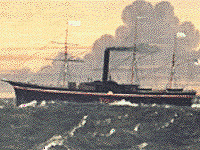 The San Francisco gold rush was a crazy time in American history. It was almost giddy in many ways. Gold does funny things to people. Just the thought of striking it rich made people pull up stakes and move west to try their hand at gold mining. Once people had made their fortunes, many decided to head back home to the east. Apparently the idea of wagon training back was not so appealing on the journey home, so these now, people of wealth decided to go by ship. The easiest crossing was through the Panama area. Of course, the Panama Canal was not built yet, although the French had tried to do so, but it wasn’t done yet. So the trip became a two ship journey.
The San Francisco gold rush was a crazy time in American history. It was almost giddy in many ways. Gold does funny things to people. Just the thought of striking it rich made people pull up stakes and move west to try their hand at gold mining. Once people had made their fortunes, many decided to head back home to the east. Apparently the idea of wagon training back was not so appealing on the journey home, so these now, people of wealth decided to go by ship. The easiest crossing was through the Panama area. Of course, the Panama Canal was not built yet, although the French had tried to do so, but it wasn’t done yet. So the trip became a two ship journey.
On August 20, 1857, several hundred passengers in San Francisco boarded the SS Sonora, of the Pacific Mail Steamship Line, and headed south toward Panama City. The 1857 value of the gold on board was 1.6 million, so just imagine today’s value. Thousands of freshly minted 1857-S double eagles, some earlier $20 coins, ingots, and gold in other forms were among the treasures. Some of the double eagles were stacked in long rows or columns and nestled in wooden boxes. Elsewhere around the ship, passengers had their own stash in purses and boxes reflecting their success in the land of gold. Once they arrived in Panama City, they were transported by train to on the Panama Railroad, which was a 48-mile line, completed in 1855 and had facilitated the crossing of the isthmus in about three or four hours as opposed to paddling and tramping through the jungles for several days. When the train arrived in Aspinwall, the passengers disembarked, and the treasure was transported to storage.
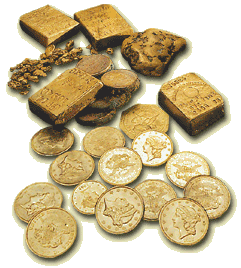 The next leg of the trip was aboard the side-wheel steamer SS Central America. The ship had been called the SS George Law, but the name was later changed to the SS Central America. It was now on its forty-fourth voyage for the Atlantic Mail Steamship Company. The Atlantic Mail Steamship Company was operating under federal mail contract to provide mail to the people between the east and west. The steamers had Navy captains at the helm, men of proven reputation and experience. Capt. William Herndon commanded the Central America.
The next leg of the trip was aboard the side-wheel steamer SS Central America. The ship had been called the SS George Law, but the name was later changed to the SS Central America. It was now on its forty-fourth voyage for the Atlantic Mail Steamship Company. The Atlantic Mail Steamship Company was operating under federal mail contract to provide mail to the people between the east and west. The steamers had Navy captains at the helm, men of proven reputation and experience. Capt. William Herndon commanded the Central America.
In early September 1857, the gold treasure was carefully packed aboard. The passengers found their cabins, and all were ready for the pleasant voyage to New York City. It was an ideal time of year for travel. A few days later, on September 7, 1857, the ship docked in the harbor of Havana. It was a popular stop for the passengers, who set about buying souvenirs and exploring the sights of the town. The trip toward New York continued to be pleasant. The skies were sunny and the sea smooth…temporarily.
At 5:30am on Wednesday, September 9, the ship’s second officer noted that the ship had gone 286 nautical miles in the preceding 26½ hours. He noted that a breeze was kicking up, and perhaps they were in for a storm, but expressed no concerns, because they were experienced and could handle a storm should it occur. That would prove to be the first mistake made. The storm grew furious and they were too far from a port to do much except keep the SS Central America into the waves. By Friday morning, September 11, the crew was still in control, but the ship was taking on water through the drive shaft, broken or open lights and elsewhere. The ship was tossing violently. It was virtually impossible to feed coal into the boilers.
At 11am Captain Herndon told the passengers that the ship was in grave danger. He enlisted the help of all men to bail water with a bucket brigade. By 1:00 in the afternoon the rising water in the hold doused the boiler 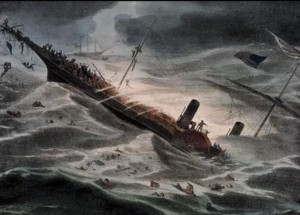 fires. The ship’s paddlewheels stopped. The SS Central America was at the mercy of the sea. By Saturday, the 12th of September, 1857, the storm started to pass, but it was too late. The SS Central America was doomed. The people were told to abandon ship, and the SS Central America went down with all of their treasure. In all, 425 lives were lost to the sea. Only 153 were pulled from a watery grave by the brig Marine, which was also damaged by the storm, though not to the degree of the SS Central America. The ship was discovered again on September 11, 1988, almost exactly 131 years after she went down in a hurricane on September 12, 1857. It was a rich find for Thomas G Thompson and his crew…and the museums who would reap much of the benefits.
fires. The ship’s paddlewheels stopped. The SS Central America was at the mercy of the sea. By Saturday, the 12th of September, 1857, the storm started to pass, but it was too late. The SS Central America was doomed. The people were told to abandon ship, and the SS Central America went down with all of their treasure. In all, 425 lives were lost to the sea. Only 153 were pulled from a watery grave by the brig Marine, which was also damaged by the storm, though not to the degree of the SS Central America. The ship was discovered again on September 11, 1988, almost exactly 131 years after she went down in a hurricane on September 12, 1857. It was a rich find for Thomas G Thompson and his crew…and the museums who would reap much of the benefits.

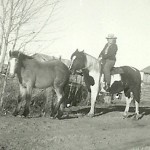 I don’t know if it was because Bob and I had been on vacation or what exactly, but when we went to visit my mother-in-law, Joann Schulenberg, she decided that she had been on vacation too. Her travels took her to San Francisco and to Oregon before finally arriving in Butte, Montana. I don’t know why she chose these particular destinations for her travels, but it is my guess that she thought she had traveled, because we told her that we had been in the Black Hills this past week. When my father-in-law, Walt Schulenberg retired, they did a bit of traveling. They liked to winter in Yuma, Arizona, and then drive to Winnemucca, Nevada to visit her sister Linda Cole and her husband, Bobby. Then, they would drive up the coast to Klamath Falls, Oregon to visit his sister, Esther Hein and her significant other, Keith Leistikaw. I suppose they would have very likely driven through Butte, Montana on their way to Forsyth, Montana to visit family in that area.
I don’t know if it was because Bob and I had been on vacation or what exactly, but when we went to visit my mother-in-law, Joann Schulenberg, she decided that she had been on vacation too. Her travels took her to San Francisco and to Oregon before finally arriving in Butte, Montana. I don’t know why she chose these particular destinations for her travels, but it is my guess that she thought she had traveled, because we told her that we had been in the Black Hills this past week. When my father-in-law, Walt Schulenberg retired, they did a bit of traveling. They liked to winter in Yuma, Arizona, and then drive to Winnemucca, Nevada to visit her sister Linda Cole and her husband, Bobby. Then, they would drive up the coast to Klamath Falls, Oregon to visit his sister, Esther Hein and her significant other, Keith Leistikaw. I suppose they would have very likely driven through Butte, Montana on their way to Forsyth, Montana to visit family in that area.
It’s hard to say for sure what things trigger my mother-in-law’s past memories to come back to her so vividly, when at other times, she doesn’t really recall them much at all. I suppose it is just the way Alzheimer’s Disease works. Sometimes the memories are there and pretty clear, and other times they are just gone. For that reason, you enjoy the memories when she has them. It is always a surprise. Unexpected, and yet always fun. When the memories come, they come with clarity, so I get a glimpse into what her life was like at that time. It’s also at times like these, that I’m thankful for the research I’ve put into her life for the different stories I have written about her, because that has enabled me to converse with her on things she remembers too.
As our time with her went on, she noticed that the clouds had begun to roll in a bit, because there was a chance of rain. But since she didn’t know what month we are in, she said it looked like it might snow. We all told her that since it was the middle of July, it most likely was not going to snow. She was not convinced, however, because as she put it, “When I was out riding my horse earlier, it was snowing.” She said it in such a 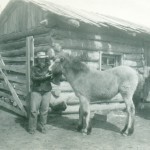
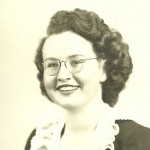 matter of fact way, that I knew she would not be convinced otherwise, so I changed the subject to her horses. We talked of Molly and Pie Face…her colt, of Danny and Twinkles, and of course, Bing. For her, it was like just yesterday that she last saw her beloved horses, because like her mom and dad, Nettie and Bob Knox…who passed in the 1980s, her husband, Walt…who passed in 2013, and her daughter, Marlyce Schulenberg…who passed in 1989, her horses are not gone. They are just at home, outside, or in the corral. They live right there, in her world, and there they will remain for as long as she lives.
matter of fact way, that I knew she would not be convinced otherwise, so I changed the subject to her horses. We talked of Molly and Pie Face…her colt, of Danny and Twinkles, and of course, Bing. For her, it was like just yesterday that she last saw her beloved horses, because like her mom and dad, Nettie and Bob Knox…who passed in the 1980s, her husband, Walt…who passed in 2013, and her daughter, Marlyce Schulenberg…who passed in 1989, her horses are not gone. They are just at home, outside, or in the corral. They live right there, in her world, and there they will remain for as long as she lives.
 While Bob and I were in San Francisco a number of years ago, we had the opportunity to ride the cable cars there. Cable cars, or trolley cars are pretty much a novelty in most places, but they used to be pretty commonplace. There are still many cities that operate a modern day version of the cable car, which is reality is more like a inter-city train than a cable car. But, the traditional cable car, street car, or trolley car were really very different from their modern day cousins, and the ride on the older version was really a lot of fun. Many cities had cable car systems that few people even remember. New York for example, has a huge subway system, but this came to be after the trolley system became problematic. Now, the old trolley system is just a faint memory, and in reality, one that is not very well known.
While Bob and I were in San Francisco a number of years ago, we had the opportunity to ride the cable cars there. Cable cars, or trolley cars are pretty much a novelty in most places, but they used to be pretty commonplace. There are still many cities that operate a modern day version of the cable car, which is reality is more like a inter-city train than a cable car. But, the traditional cable car, street car, or trolley car were really very different from their modern day cousins, and the ride on the older version was really a lot of fun. Many cities had cable car systems that few people even remember. New York for example, has a huge subway system, but this came to be after the trolley system became problematic. Now, the old trolley system is just a faint memory, and in reality, one that is not very well known.
In fact, problematic was maybe an understatement when it comes to reality concerning the cable car system. Once the automobile became a common item in the American household, there were a number of incidences involving the automobile and the trolley 
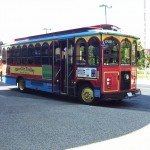 or cable car. I’m sure you can guess who won that battle. The trolley or cable car was bigger, and it was after all, limited as to where it could operate, while the automobile was free to go where it chose…pretty much anyway. Nevertheless, there were collisions between the two forms of transportation…as well as traffic jams at times. Eventually, with automobiles becoming so commonplace, the trolley or cable car began to go by the wayside…Finally ending up as the novelty it is today.
or cable car. I’m sure you can guess who won that battle. The trolley or cable car was bigger, and it was after all, limited as to where it could operate, while the automobile was free to go where it chose…pretty much anyway. Nevertheless, there were collisions between the two forms of transportation…as well as traffic jams at times. Eventually, with automobiles becoming so commonplace, the trolley or cable car began to go by the wayside…Finally ending up as the novelty it is today.
When my daughter, Corrie Petersen and I were in Minneapolis in August of 2005, we had the opportunity to take a city tour on an old trolley car. Of course this one was of the variety that had come out when the automobile came out. It needed no cable, but was rather a trolley car bus, I suppose. The seats and the windows were definitely authentic trolley car though. The tour was a lot of fun…probably mostly because it was a novelty trip. Bob and I had an additional opportunities in Alaska, on a tour of Anchorage. I really like the 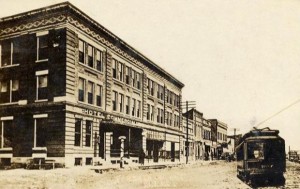 trolley car tours.
trolley car tours.
The other day I was looking at some old pictures of Montana history, and I came across something about Forsyth that I didn’t know about before. The little town of Forsyth, population about 1400 people in 1914, with one maim street is a place that you can easily walk across in just a few minutes. Nevertheless, the little town of Forsyth, Montana had a cable car in 1914, so people could ride the length of that main street…probably eight to twelve blocks. I was amazed to learn of that little tidbit of Forsyth history, which was the place where many of Bob’s family members lived, and where many still live today.
 Some challenges are tougher than others, and the challenge to connect San Francisco with Marin County, California rates right up there among the most difficult…at least in 1937. I’m sure there have been bigger challenges since then and even before then, but I think that building what was the longest suspension bridge in the world in 1937 had to be really difficult. The bridge, which was built between January 1933 and May 1937, was to be 4,200 feet long. Its location was probably the biggest challenge the builders faced. The bridge is very close to the San Andreas Fault, which runs north and south directly through the San Francisco area. The bridge had to be built in such a way as to ensure its stability in the event of an earthquake. While earthquakes can happen anywhere in the world, it is such a strange idea to me to build something that depends on solid ground, on a known fault. Nevertheless, the bridge still stands today, and there have been many earthquakes in that area.
Some challenges are tougher than others, and the challenge to connect San Francisco with Marin County, California rates right up there among the most difficult…at least in 1937. I’m sure there have been bigger challenges since then and even before then, but I think that building what was the longest suspension bridge in the world in 1937 had to be really difficult. The bridge, which was built between January 1933 and May 1937, was to be 4,200 feet long. Its location was probably the biggest challenge the builders faced. The bridge is very close to the San Andreas Fault, which runs north and south directly through the San Francisco area. The bridge had to be built in such a way as to ensure its stability in the event of an earthquake. While earthquakes can happen anywhere in the world, it is such a strange idea to me to build something that depends on solid ground, on a known fault. Nevertheless, the bridge still stands today, and there have been many earthquakes in that area.
The second challenge the builders faced was the tumultuous waters the bridge had to span. The dangers that presented for the underwater construction were grave. The construction teams started their work on the peninsulas, building out over the wind-whipped waters of the San Francisco Bay. With labor and 70,000 tons of steel, they built arms that reached out to each other over the straits, getting closer by the day. Given the strait’s precarious mixture of violent winds, swirling currents, and thick fogs, many thought such a bridge couldn’t be built. Nevertheless, the builders have prevailed against the challenges they faced, because the bridge was completed successfully. In all, eleven men would lose their lives during construction, ten of them on February 17, 1937 when a section of scaffold carrying twelve men fell through the safety net.
I think the biggest challenge, that did not involve the elements, was a city who was skeptical and many people who were simply against a bridge across the San Francisco Bay. Nevertheless, Joseph Strauss, the engineer fought for 16 years to convince the people that the bridge was an amazing idea. He was a very proud man when he, on opening day, triumphantly exclaimed, “The bridge which could not and should not be built, which the War Department would not permit, which the rocky foundation of the pier base would not support, which would have no traffic to justify it, which would ruin the beauty of the Golden Gate, which could not be completed within my costs estimate of $27,165,000, stands before you in all its majestic splendor, in complete 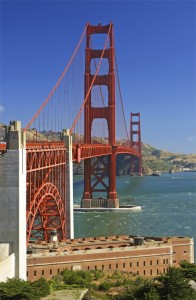 refutation of every attack made upon it.”
refutation of every attack made upon it.”
And so it was that the seemingly impossible was accomplished. The bridge was set to open on May 27, 1937, and by 6:00am, 18,000 people were lined up on both the San Francisco and the Marin county sides. In all, about 200,000 people showed up that day. At the appointed hour, a foghorn blew, and the toll gates opened. The earliest arrivals would have the distinction of being among the first to cross. Many offices, schools, and stores closed to attend the great event. The day was designated Pedestrian Day. The next day, he bridge opened to vehicle traffic. President Franklin Delano Roosevelt proclaimed the bridge open to the world. By the end of that day, 32,000 vehicles had paid the tolls and crossed the historic bridge. In the 70 plus years it has been open, it is estimated that nearly 2 billion vehicles have crossed the bridge. The Golden Gate Bridge and the views it holds are beautiful, and I am happy to have been one of those people to have crossed it.
 When my husband, Bob Schulenberg and I went to San Francisco for the first time, we wanted to make sure we saw all the sights of the area. I was especially interested in Alcatraz Prison, partly because of it’s unique location, but also because of its history. While visiting the prison, we had the opportunity to visit with an author, who had actually been an inmate at the prison. Jim Quillen recounted the years he spent at the prison, the corruption, abuse, and the Battle of Alcatraz, which took place from May 2, 1946 to May 4, 1946. The battle began with an unsuccessful escape attempt, and ended with the deaths of two guard, William A. Miller and Harold Stites, as well as three of the inmates. Eleven guards and one inmate were injured, and two convicts were later executed for their actions.
When my husband, Bob Schulenberg and I went to San Francisco for the first time, we wanted to make sure we saw all the sights of the area. I was especially interested in Alcatraz Prison, partly because of it’s unique location, but also because of its history. While visiting the prison, we had the opportunity to visit with an author, who had actually been an inmate at the prison. Jim Quillen recounted the years he spent at the prison, the corruption, abuse, and the Battle of Alcatraz, which took place from May 2, 1946 to May 4, 1946. The battle began with an unsuccessful escape attempt, and ended with the deaths of two guard, William A. Miller and Harold Stites, as well as three of the inmates. Eleven guards and one inmate were injured, and two convicts were later executed for their actions.
While most of the inmates and guards were in outside workshops, inmate Bernard Coy, a bank robber serving a 25 year sentence at Alcatraz, was in the main cellhouse sweeping the floor around C Block. Kitchen orderly Marvin Hubbard called on guard William Miller to let him in. He had just finished cleaning the kitchen. As Miller was frisking Hubbard for any stolen articles, Coy attacked him from behind and the two men overpowered the officer. They then released Joseph Cretzer and Clarence Carnes from their cells. They went to the gun gallery and obtained a rifle. As they attempted to make it down to the dock, hoping to catch the incoming boat, they quickly realized that was not going to work. Then, they decided to go back to prison and take some hostages.
At 10:00pm, unarmed guards went into the cellhouse. They were covered by armed guards in the two gun galleries overhead. They found the hostages, but one guard was wounded by a gunshot fired from the roof of one of the cell blocks. Then they locked the open door to D Block, and when the last officer reached safety, the  guards opened fire with a massive barrage from machine guns, mortars, and grenades on the prisoners within D Block. The prison authorities thought one of the armed convicts was holed up there, but they were wrong. They eventually figured out that the rebellious prisoners were confined to the main cellhouse and ceased their attack until further tactics were worked out. Jim Quillen told us that the men tried hiding behind their mattresses, or anything else they could think of, but it was really no protection at all. The battle lasted until May 6th. Alcatraz was the home to many of the most notorious prisoners, and many said it was filled with corruption and abuse from the guards. After a checkered past, it became a tourist attraction, and continues as such today.
guards opened fire with a massive barrage from machine guns, mortars, and grenades on the prisoners within D Block. The prison authorities thought one of the armed convicts was holed up there, but they were wrong. They eventually figured out that the rebellious prisoners were confined to the main cellhouse and ceased their attack until further tactics were worked out. Jim Quillen told us that the men tried hiding behind their mattresses, or anything else they could think of, but it was really no protection at all. The battle lasted until May 6th. Alcatraz was the home to many of the most notorious prisoners, and many said it was filled with corruption and abuse from the guards. After a checkered past, it became a tourist attraction, and continues as such today.
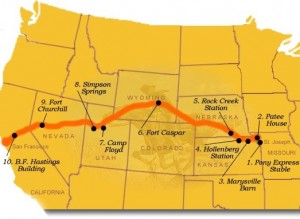 I often wonder how it must have felt to live in a time when so many things were changing in ways that man had not seen before. Things like the automobile, the airplane, the light bulb, the telephone, and the telegraph, all came into being between the 1800s and the early 1900s. Prior to these things, our world was rather primitive concerning things like travel, communication, and even the home life…at least by today’s standards, anyway.
I often wonder how it must have felt to live in a time when so many things were changing in ways that man had not seen before. Things like the automobile, the airplane, the light bulb, the telephone, and the telegraph, all came into being between the 1800s and the early 1900s. Prior to these things, our world was rather primitive concerning things like travel, communication, and even the home life…at least by today’s standards, anyway.
When families began moving West to find land and adventure, it was often a very sad time, because many of these people would not see their loved ones again. They might not even hear from them. This really seemed like an unacceptable situation for most of the people on both sides of that spectrum. The people needed to hear from their loved ones, and so like every other idea, from necessity came a solution…the Pony Express. Prior to the Pony Express, people might try to send a letter with a wagon train heading West to see of they could manage 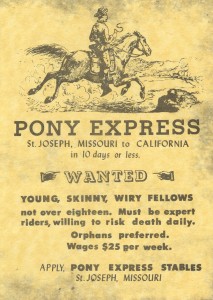 to get it to a loved one who had left a year or more before. Imagine the impossibility of that feat. The person with whom the letter was sent, might not even know the person to whom the letter was being sent. It meant asking around in the area they had planned to settle in, and if they had moved elsewhere…well that is the real definition of the dead letter.
to get it to a loved one who had left a year or more before. Imagine the impossibility of that feat. The person with whom the letter was sent, might not even know the person to whom the letter was being sent. It meant asking around in the area they had planned to settle in, and if they had moved elsewhere…well that is the real definition of the dead letter.
The Pony Express became the first dedicated postal service ever, on this day, April 3, 1860, but it was a far cry from the mail service of today, about which many of us complain. The men who chose to be Pony Express riders had to be told about what they might be riding into. There were Indians, who did not like the White Man. Treaties had been broken, and the White Man was considered an intruder on Indian land. To say that the White Man was not welcome in the West, was putting it mildly. Every time the Pony Express rider set out, he was taking on the risk of never coming back. The Help Wanted posters clearly stated the dangers, and the riders had to be single young men preferably under eighteen and preferably orphans!! Not a glowing help wanted ad, for sure, still there was a need, and these brave men took the challenge and made it work. The Pony Express was a short lived phenomenon, however, lasting just eighteen short months. I suppose something had to be done to make mailing a letter safer. At the point when the last Pony Express rider rode his route, the telegraph had somewhat 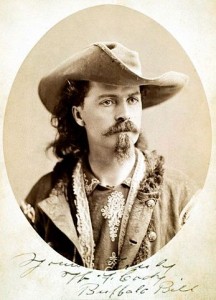 taken its place. Most what had been needed was to be able to let people about the death of loved ones and other urgent or important news, so it seemed like an unnecessary risk to place on these men, when a safe way had been found.
taken its place. Most what had been needed was to be able to let people about the death of loved ones and other urgent or important news, so it seemed like an unnecessary risk to place on these men, when a safe way had been found.
The first Pony Express rider to make the run has been a matter of dispute, but historians have narrowed it down to Johnny Fry or Billy Richardson. James Randall was credited with being the first Eastbound rider, heading out from San Francisco to Sacramento, and William (Sam) Hamilton took the mail from there to the Sportsman Hall Station, where he handed it off to Warren Upson. Other riders were Gus and Charles Cliff, Robert Haslam, Jack Keetley, Billy Tate, and the famous William Cody, known to most of us as Buffalo Bill. Together, these men rode into history as some of the bravest men who ever lived. Riding alone through dangerous territory, risking their lives to make life a little easier for the ever expanding nation we lived in.
 On a trip to San Francisco, my husband, Bob and I took a tour of Alcatraz Prison. I expected it to be a usual touristy place, even though it had been the nation’s end of the line maximum security prison. It was where they sent the most incorrigible inmates. When we arrived, the island known as The Rock or America’s Devil Island to the inmates who did time there, really looked more like an industrial island than a prison, but you could see why it was called The Rock. Of course, that first view of the island was the last time I thought it didn’t look like a prison.
On a trip to San Francisco, my husband, Bob and I took a tour of Alcatraz Prison. I expected it to be a usual touristy place, even though it had been the nation’s end of the line maximum security prison. It was where they sent the most incorrigible inmates. When we arrived, the island known as The Rock or America’s Devil Island to the inmates who did time there, really looked more like an industrial island than a prison, but you could see why it was called The Rock. Of course, that first view of the island was the last time I thought it didn’t look like a prison.
Upon stepping inside, you felt an immediate, almost claustrophobic sensation, and I’m not claustrophobic. The cells were often painted black inside. It was a way of achieving privacy for the inmate. To me it just seemed bleak. I could imagine how it must have been…knowing that you could not leave this dark and ominous place. Alcatraz operated from the mid 1930s to the mid 1960s, and housed over 200 inmates. Well known for it’s brutal conditions, Alcatraz was thought to be inescapable due to the frigid waters of the bay. One group of prisoners either died or proved the rumors wrong, when they escaped and were never heard from again. Their fate is still unknown. The prisoners had to comply with very strict rules, and were required to live in complete silence. The first metal detectors were used at Alcatraz. No wonder the prisoners considered escape, knowing it meant almost certain death. Eventually, the conditions and treatment of the prisoners were deemed cruel and unusual punishment, and on March 21, 1963.
First explored by Juan Manuel de Ayala in 1775, it was originally called Isla de los Alcatraces, which meant  Island of the Pelicans. It was sold to the government in 1849. The first lighthouse in California was on Alcatraz. It was once a Civil War fort and then a military prison in 1907. Finally it became the maximum security prison known as The Rock. After it’s closing, a group of Sioux Indians claimed that the island belonged to them due to a 100 year treaty. Those claims were ignored until November of 1969 when a group of Native Americans representing the American Indian Movement, or AIM occupied the island. They stayed until 1971 when they were finally forced off of the island by federal authorities. The next year it was added to the Golden Gate National Recreation Area and opened for tourism. It was a very interesting tour to say the least.
Island of the Pelicans. It was sold to the government in 1849. The first lighthouse in California was on Alcatraz. It was once a Civil War fort and then a military prison in 1907. Finally it became the maximum security prison known as The Rock. After it’s closing, a group of Sioux Indians claimed that the island belonged to them due to a 100 year treaty. Those claims were ignored until November of 1969 when a group of Native Americans representing the American Indian Movement, or AIM occupied the island. They stayed until 1971 when they were finally forced off of the island by federal authorities. The next year it was added to the Golden Gate National Recreation Area and opened for tourism. It was a very interesting tour to say the least.

